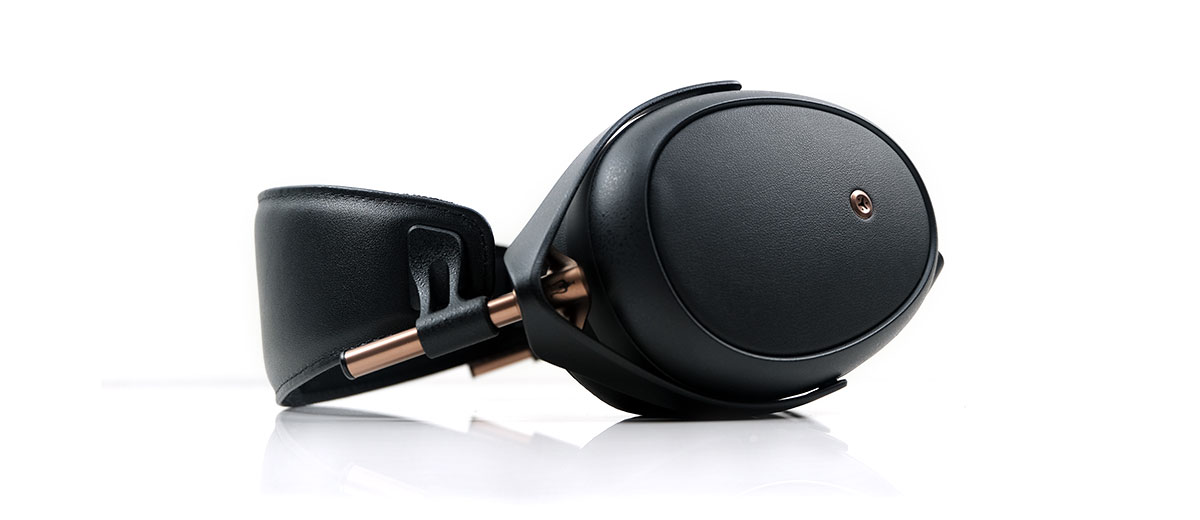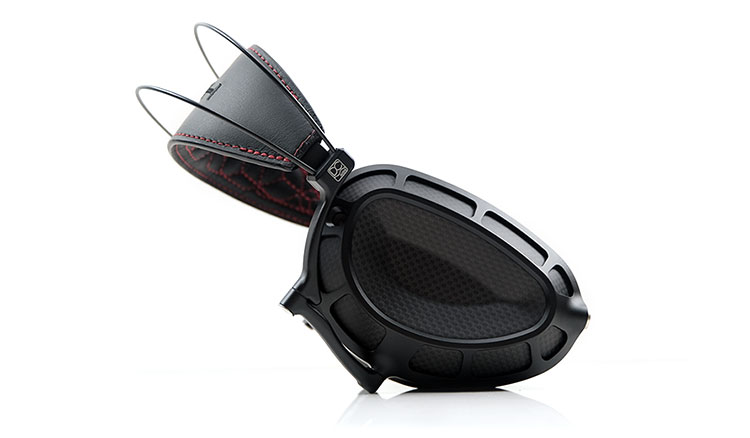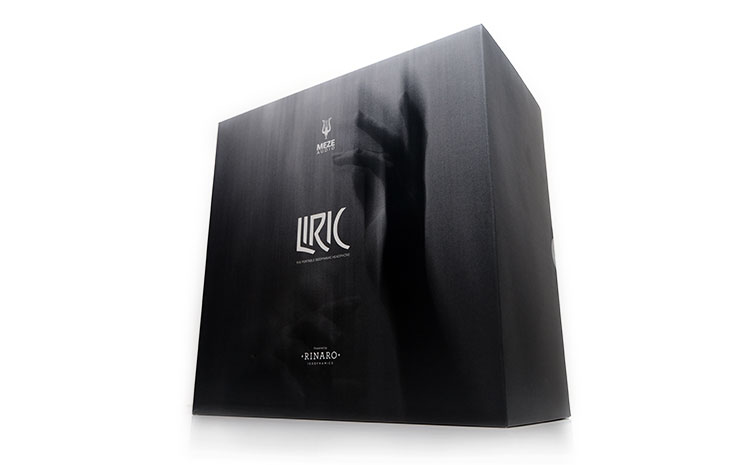Select Comparisons
Meze Audio Empyrean
$2999
The Empyrean was reviewed by us back in early 2019 and it walked away with our Top Gear Award for that year also. Some of the limelight for the Empyrean has been stolen recently by the new Elite Flagship but since its driver has a closer relationship to the Liric version it felt the more natural comparison.
Technical
The Empyrean is of course an open-back Isodynamic hybrid array driver headphone as opposed to the closed-back Liric. It also has a larger driver with improved fiberglass reinforced ABS and a bigger active area of 4650mm². The Liric’s MZ4 driver uses reinforced polymer with a reduced 3507mm² active size.
Voice coil implementation is very similar with both drivers using a switchback and spiral-shaped design but due to the nature of closed-back acoustical space, the Liric has been augmented with Meze’s new Phase-X™ system to combat distortion and enhance the perceived staging space.
The Liric also benefits from the venting PES tech but is nowhere near as open as the Empyrean.
The sensitivity rating of both headphones on paper is very similar with the Empyrean at 31.6Ω and 100dB SPL compared to 30Ω for the Liric and the same 100dB SPL rating. However, testing with the HYPSOS and OOR with Ferrum on a balanced output I found the Liric needed just a tiny bit more current to properly volume match the Empyrean.
It is debatable though if truly more sensitive or simply the larger driver and open design of the Empyrean create an inherently ‘bigger’ sound compared to the smaller Liric driver.
Design
How these two headphones will appeal to you will come down to your envisaged usage scenarios.
If you are out and about, need to move around a lot whilst using a headphone, and desire really good isolation then the Liric is the better design. It is lighter, more compact, and does an excellent job of blocking out a lot of background noise when in use.
Both the Liric cables are relatively non-intrusive and lightweight to complement that active lifestyle though I find their overall quality to be a step down from the stock Empyrean OFC cable and especially the balanced XLRR-terminated Furukawa copper alternatives.
If you are planning on staying indoors within a quiet room and looking for a higher quality of playback then the Empyrean is the better choice. The weight gap is not huge but it is a bigger headphone than the Liric with the eye-catching higher-quality finish and more elaborate engineering.
The detachable pads in particular make a better long-term indoor listening choice whereas the 4-pin mini-XLRs are more durable for me personally. Comfort-wise on the head, I would place them on the same level but the larger inner cavities of the Empyrean give them an edge for ear comfort for longer listening sessions.
Performance
Two stories coming out of this comparison. The first is the tuning which will split camps and the second, is the technical side which shouldn’t really. Starting with the latter, the Empyrean is technically the better performer but then again it’s an open back and more expensive so you should expect that.
It delivers more in terms of micro-detail for note texture as well as an improved soundstage with its open-back design. The imaging complexity is better. I think Meze did an excellent job with the Liric in terms of height and depth but it doesn’t have the same borderless width as the Empyrean.
However, the imaging within that more intimate staging performance is excellent. Aided no doubt by that change in tonal qualities, you get plenty of clarity front to the back of the more intimate stage from the Liric.
The tuning is a different matter and it will be quite preferential. The Empyrean is richer, denser through the lower mids, and more relaxing on the highs. It has a broader upfront euphony to the vocal timbre that makes it very easy to listen to.
At the same time, others might find it too relaxing and this is where the Liric makes its difference felt.
There is a lot more contrast and energy in the Liric performance with a stronger mid-bass punch, a bump again at the 1-2k region for some vocal balance, and a relatively forward 2-5k range.
The upper treble has more energy than the Empyrean which colors a more neutral-bodied upper mids with more sparkle or sheen.
Sibilance can be more of a factor depending on the audio mix and how bright it is. Lower mids can also be a bit thinner with more of a 200Hz to 500Hz dip for separation.
Audeze LCD-XC 2021
$1299
The 2021 edition of the long-running LCD-XC was reviewed by us in 2021 and though slightly cheaper than the Liric, it’s probably one of the nearer closed-back planar competitors.
Technical
Both headphones have closed-back designs, however, the driver technology is quite different. The LCD-XC 2021 uses a larger rounded Ultra-Thin diameter planar diaphragm compared to the 92mm x 63mm ovoid Isodynamic hybrid array MZ4 inside the Liric.
For phase control and to reduce wave interference, Audeze relies on their patented Fazor technology inside the XC 2021 with 6 Fazor ‘windows’ combined with stacked Neodymium N50 magnets in a dual-sided array.
Distortion and minimizing phase interference inside the Liric driver design is done via the Phase-X™ system though, to be honest, Meze has not gone into a huge breakdown on how that works to the same extent as Audeze with Fazor.
Suffice it to say the end goal is similar and that is to improve transparency and spatial imaging, important aspects in a closed-back design.
One thing to note also is that both headphones make greater use of their pads in fine-tuning the airflow and final sound signature.
Audeze slightly lifted the XC 2021 pad ring from the main housing a little further to enhance the ventilation performance of the LCD-XC 2021, which in turn became a factor in the headphone’s improved tuning over the original
The Liric pads go further with their new Earpad Air Flow (EAF) system that adds to the overall size of the headphone’s acoustic volume through a series of precision-cut air vents from the chamber into the pads themselves.
This allows the pads to be small, and breathe in the same manner combined with PES without the traditional stuffy closed-back earphone feel.
Both are easy to drive with low impedance loads and 100dB SPL ratings on paper but in real-world tests with the Ferrum OOR using balanced outputs, the Liric required a little more current to volume match properly.
Design
No question the Liric is the more portable of the two headphones being far more compact and portable and just over 285g lighter.
Despite the almost equal levels of isolation from those thick and lush leather-free pads, (leather optional), the LCD-XC 2021 is still very much a standstill and don’t move experience.
By that phrase, I mean indoor headphones or limited movement due to the weight. I still find it comfortable; the pressure balance is excellent but excellent for a 677g headphone. The Liric can be bagged and moved around with much greater ease.
Materials wise they are different and fairly even in their engineering with LCD-XC 2021 using a mix of machined aluminum rings, leather pressure straps, wide gimbal composite arches with screws on both ends, and pivot screws with blocks. It is a classic and sturdy LCD design meant to hold that weight securely together.
The Liric’s compact form factor is sleeker and can afford to be given its reduced weight. The cups are ovoid instead of circular, the plates are leather-finished with a lighter magnesium skeleton, and the headband is lower-profile and just as comfortable.
Aesthetics-wise the Liric is more advanced and flowing for me though the LCD-2 XC has a bit more of a visual pop with that carbon fiber dome cup finishing and simply the sheer size of it.
Performance
As with the Empyrean, there are some technical and tuning differences though on this occasion I wouldn’t rate this comparison as one being overtly better than the other.
Again, it is a preference issue with the Liric’s more boisterous levels of energy at the extreme ends of the FR. That means a stronger sub-bass presence with a more energetic mid-bass punch as well as an elevated level of upper-treble presence.
The LCD-XC 2021’s bass tuning is more refined, and linear in a way but not as showy or heavy below 100Hz. Because of the stronger rise of the Liric, its cut in dB is more significant into the mids whereas the XC 2021 is more gradual.
It sounds more coherent for me but it does lack the Liric’s bass weight and that results in a stronger PRaT that some might prefer.
Both show a degree of forwardness in the mids, particularly from 1-4k for the XC 2021. I do think the XC 2021’s staging width and stereo imaging are wider than the Liric with a degree of improved openness but imaging accuracy on both is very good.
The Liric can stretch taller, making the XC 2021 sound more mid-centric. However, in return, the timbral balance is slightly calmer for vocals whereas Liric’s high-contrast energetic mix can sound steelier on high-pitched percussion strikes with a stronger sibilant overtone.
I would probably pick the Liric for modern rock and pop, the better fundamental gives it a bit more drive and sparkle. The LCD-XC 2021’s more refined vocal delivery and wider stereo imaging make it a better contender for mid-centric music.
Dan Clark Audio Stealth
$4000
The Stealth was reviewed last year and won our Top Gear Closed-Back headphone award for the same year. It is much more expensive so worth comparing for those with tighter budgets.
Technical
Both are closed-back but internally those drivers are quite different with the Stealth using DCA’s latest single-sided V-Planar driver combined with their new tuning system called AMTS.
Interestingly, the driver inside the Liric is bigger at 92mm x 63mm compared to the 72mm x 50mm driver inside the Stealth. However, the active area size on the Stealth driver is unknown but it is possible it is smaller given the smaller driver size.
Waveguide and diffusion control are also quite different with the DCA Acoustical Metamaterial Tuning System or AMTS the highlight of the Stealth and the Liric using the Phase-X system.
In a nutshell, AMTS is a programmable physical ‘honeycombed wedge’ with the aim of creating a more natural and immersive soundstage within a closed-back design.
It can also act as a quarter-wave resonator to control high-frequency standing waves and resonance via the ‘ramped’ shaped design starting at 8kHz at the peak of the ramp down to 20kHz at the base of the ramp.
Less is known about the specifics of the Phase-X but diagrammatically the aim is similar in terms of that natural soundstage for a closed-back combined with the PES and Earpad Air Flow (EAF) inside the cups and pads of the Liric.
Ratings-wise, the Stealth needs a good amp to sound just right and one also with an earthy low-end performance to get as much excursion as possible on the driver.
At 87dB it is far harder to drive compared to the Liric which is rated at 100dB SPL. Unless you are using a powerful portable source such as the FiiO M17, the Stealth is primarily for home use.
Design
The Stealth has better engineering and materials in its design but the comfort of the Liric is on par and the isolation is just slightly better also.
Combined with the easy-to-drive rating, the Liric lives up to the portable ethos just a little bit more except for one major design difference, the folding mechanism in the Stealth.
With the articulated folding design, the Stealth size just halves like that for transportation and comes with an equally compact carry case to ram that point home. It makes the non-folding Liric look huge in its case by comparison.
The unfolded Stealth is a little bit bigger though and marginally heavier at 415g compared to the Liric’s 391g. Its form factor is also a little more cup-dominant with a slightly looser clamp but the pressure distribution is excellent due to the elasticated adjuster strap.
The Liric’s genuine leather headband with padded headband cushions is a little less flexible but still incredibly comfortable with a very good pressure distribution also.
The Stealth internal pad cavities are larger so it’s not quite as close to your ear as the Liric’s tighter pads. In truth neither is going to really give your ears any issues for long listening but the Liric closeness makes them a shade warmer after a while.
Performance
This is a case of Stealth’s natural tonal balance and accuracy versus the Liric’s energetic PRaT and high contrast coloration.
There is also a difference in staging. The Stealth is more resolving and stretches wider in its staging width but is not as voluminous on the low end nor as sparkling on the highs. It still sounds more open but its 3k peak pulls you much more into the midrange and its accompanying smoother vocal performances.
That additional staging width does not mean a diffuse pitter-patter from the Stealth. Wide staging cues are firmer sounding on the Stealth and thinner and less distinct on the Liric.
What the Liric does really well is to deliver a punchier low-end. Combined with a stronger upper treble it makes for a more dynamic presentation but a cleaner sound.
The Liric is not as smooth or as distortion-free as the Stealth throughout whose timbral consistency is remarkable. But what it lacks in consistency it makes up for in energy, rumble, and sparkle. You could argue it’s the more joyful of the two but it could depend entirely on what you are listening to.
For example, vocals and instruments on the Stealth are much more refined, less likely to produce sibilance, and physically quite solid in terms of weight.
Harmonically they are very balanced, not too smooth or bright. Vocals on the Liric can excite but also trip up a bit more from the upper treble overtone if the mix is bright.
Amp synergy for both is key with the Liric sounding better for me on tubes or R2R DAPs which tend to be less treble-happy. The Stealth can handle tonal variations better but it needs a lot more power to tickle the low-end to a satisfactory level.
Our Verdict
The Meze Audio Liric is a welcome addition to a growing closed-back planar headphone market. It brings excellent design and comfort fundamentals from their TOTL headphones into a smaller and more compact size as well as producing class-leading levels of isolation.
Moreover, it has a likable but more aggressive sound signature than what Meze Audio fans might be used to coming from the Empyrean and Elite.
It gives up a bit in terms of resolution and dynamic range to its bigger brothers but in return, you get something much more immediate, fun if you like, and an entirely suitable high-end listening experience for portable audio fans.
Don’t let that stop you from plugging it into a big old fat desktop tube amp. It sounds marvelous from the few we tried in this review thus far so it can just as easily sit in the house as an enjoyable home audio purchase.
Meze Audio Liric Specifications
- Driver Type Rinaro Isodynamic Hybrid Array® MZ4
- Operating Principle Closed
- Ear Coupling Circumaural
- Frequency Response 4-92,000 Hz
- Impedance 30 Ω
- Nominal SPL 100 dB (1 mW / 1 kHz)
- Maximum SPL > 130 dB
- Total Harmonic Distortion (THD) <0.15%
- Weight 391 g






